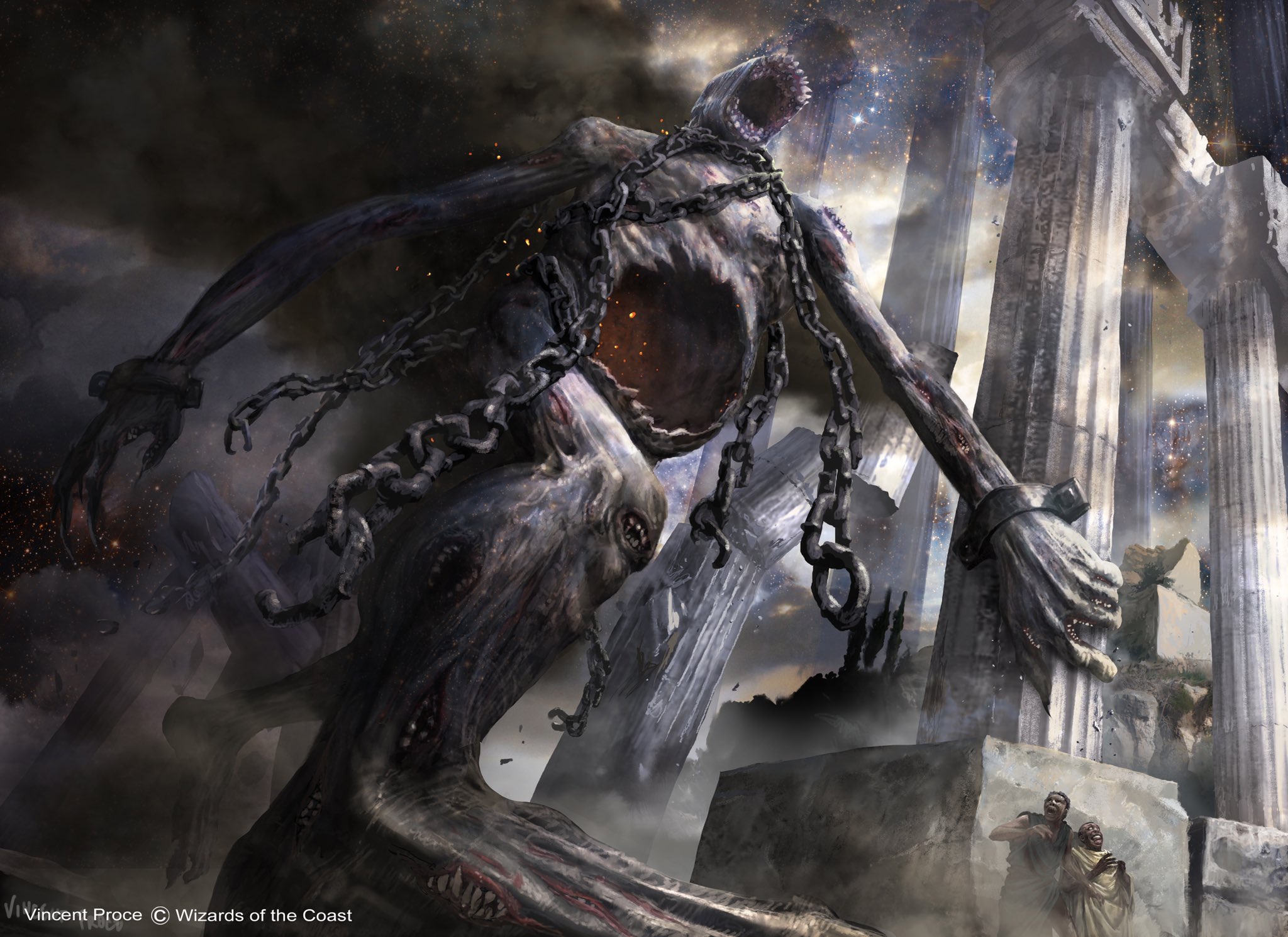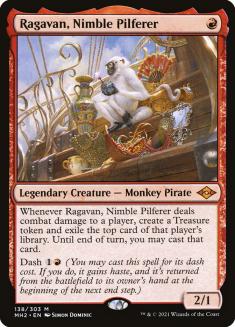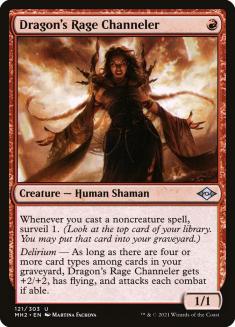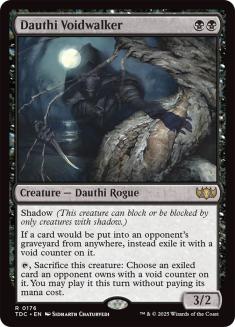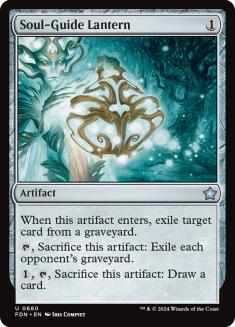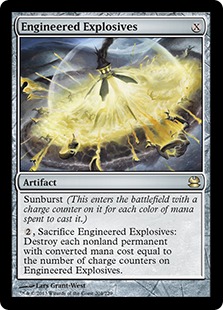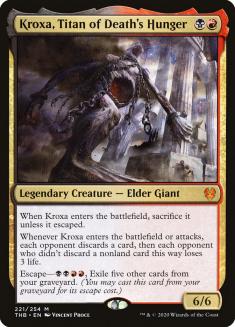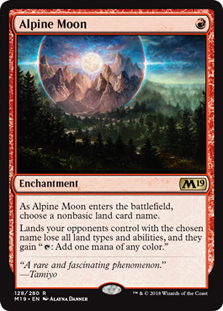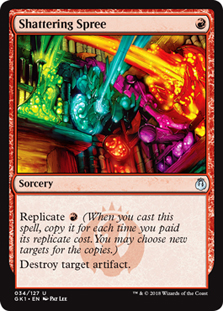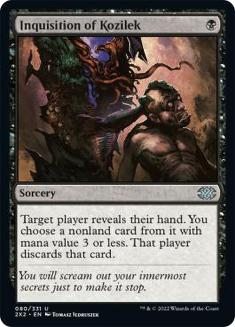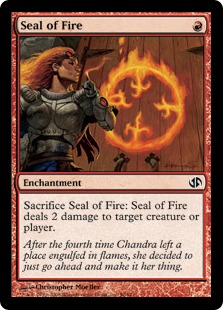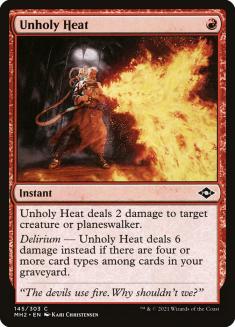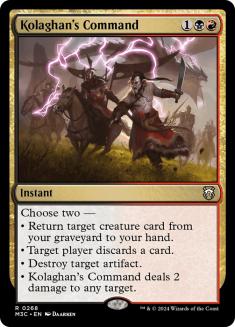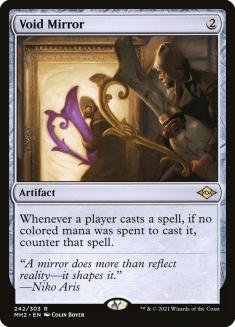Today’s article will focus entirely on the ins and outs of sideboarding with one of the best decks in Modern. Rakdos Midrange (Lurrus) is a relatively new archetype, powered in most part by three different creatures from Modern Horizons 2.
These three creatures make up the core of the archetype, giving you powerful and cheap threats that can apply pressure while threatening card selection, card advantage, or mana advantage.
Ragavan, Nimble Pilferer might be the best one-drop creature ever printed. Its dominance in Legacy might push it to legendary status sooner rather than later, but that might be the fault of Daze more than anything else. In Modern, the dynamic duo of Dragon’s Rage Channeler and Ragavan just feels right. They’re both excellent one-drops, but they promote a different type of gameplay compared to Goblin Guide and Monastery Swiftspear. Within that gameplay pocket that DRC and Ragavan create lie some of my favorite archetypes.
Here’s the list we’ll be using today:
Creatures (15)
- 3 Kroxa, Titan of Death's Hunger
- 4 Dragon's Rage Channeler
- 4 Ragavan, Nimble Pilferer
- 4 Dauthi Voidwalker
Lands (20)
Spells (25)

All the cards in this deck have been put through the wringer. Instead of breaking down why each and every card is in the deck, we’re going to focus specifically on how to sideboard in the most common matchups in Modern. I’ll go over our role in the matchup, highlight which styles and specific cards are good or bad, and give you my suggested ins/outs. Let’s begin with the mirror and move from there.
VS Rakdos Midrange (Lurrus)
The mirror is all about attrition: you want to gain the most out of every card possible. Your life total should be used as a resource, but never forget that it can dissolve in an instant thanks to Lightning Bolt, Ragavan, and Kroxa, Titan of Death’s Hunger.
Lurrus of the Dream-Den is one of the most important cards in the mirror because it’s a guaranteed free card if you don’t expose it to a discard spell. There’s some amount of risk versus reward you need to take into consideration, as spending your mana when it would otherwise go unused is integral to success in Magic.
With that said, if you aren’t under any pressure from the opponent, opening yourself up to exploits so you can be more efficient might not be the way to go. Figuring out the right spots to put Lurrus into your hand is one of the more difficult choices in this specific mirror.
Out:
In:
I have waffled on whether or not Engineered Explosives is worth bringing in. On the one hand, it helps catch you back up when you’ve fallen behind. On the other, you should be bulldozing every threat your opponent plays casts the turn they cast it. Your opponent should rarely have more than one creature on the battlefield at any given time, which makes Engineered Explosives more of a liability than helpful option.
Pyrite Spellbomb is a consideration if you want to drastically reduce the number of discard spells in your deck. However, the current iterations of attrition battles aren’t exactly the same as they used to be. When Liliana of the Veil was rampant, it made sense to empty your hand as quickly as possible. That meant drawing discard spells later in the game made them mostly dead. With Lurrus in the format and Mishra’s Bauble creating “slow draws,” discard spells will have value, albeit reduced, in later turns.
Removal, discard, and threats are basically all our deck is made up of. It’s important to have the right removal for the right threats, including stuff like Terminate and Unholy Heat to handle an opposing Kroxa. Reducing the raw number of discard spells makes sense because it’s one of the worst forms of interaction in these battles because it offers a net negative mana investment, and few cards actually generate added value by being cast. In the future, I will likely have a few more sideboard cards that could help in the mirror, and I will most likely be sideboarding out all copies of Thoughtseize to accomodate them.
VS Izzet Midrange
Creatures (13)
Lands (18)
Spells (29)

We’ve actually made significant changes to our deck because of this matchup. Terminate is almost specifically to help kill Murktide Regent, and has regularly been the tool of choice for Rakdos decks to kill large delve threats. Older versions of Rakdos Midrange relied on Unholy Heat and Fatal Push to do the lifting that Lightning Bolt couldn’t, but the advent of larger threats and their prevalence in the format requires us to tune. Terminate is just a means to an end, but still reasonably efficient in other matchups.
Their deck is similar to ours, but we have the upside of a companion and Kroxa, the midrange killer. If they ever stick Murktide Regent and can protect it from our Terminate, things will go poorly for us. Our discard effects are actually quite strong here, as their reliance on Counterspell means they’ll be holding up protection on the regular. In truth, our decks are similar, and I’ve definitely considered splashing blue for Expressive Iteration only. However, I think discard as our main form of interaction instead of Counterspell is not only more efficient, it makes our threats better because we get to use our disrpution proactively. It’s also cheaper.
Some slower versions exist that are in a perpetual state of moving on and off Archmage’s Charm. Any card advantage card that helps them win the long game makes life harder for us. I don’t expect many people to be on Archmage’s Charm yet, but they should continue to push toward that direction if attrition becomes the name of the game. When that happens, we’ll have to adjust again.
Out:
N/A
In:
N/A
Because our sideboard is so focused on beating our bad matchups, I don’t recommend changing any cards between maindeck and sideboard. Your discard effects are all good, and Thoughtseize just so happens to be one of the easier ways to handle Murktide Regent. Soul-Guide Lantern isn’t that great, even if it does exile their graveyard. Timing your graveyard removal spells against creatures with delve is pretty tough, and I don’t know that I would want something like Soul-Guide Lantern because it trades down on resources. We’re also heavily slanted toward beating this deck in Game 1 thanks to the addition of Terminate.
Even though stuff like Pyrite Spellbomb would be fine, it’s not really better than anything else in our deck for this specific matchup.
VS Izzet Prowess
Creatures (17)
- 4 Monastery Swiftspear
- 1 Bedlam Reveler
- 3 Soul-Scar Mage
- 2 Sprite Dragon
- 3 Stormwing Entity
- 4 Dragon's Rage Channeler
Lands (18)
Spells (25)

This matchup is similar to Izzet Midrange but is a bit more aggressive. That’s good for us, because our deck is pushed to be interactive to a fault, and their deck thrives on opponents not interacting at all. Their copies of Mutagenic Growth can be problematic, and they can just kill you out of nowhere, so don’t get a big head. Be careful, and treat this deck with respect. Protect your life total as much as possible, and don’t be afraid to get blown out.
Killing stuff on your own turn is usually preferred because it means you don’t get punked for extra damage due to prowess. They are more aggressively slanted so keeping hands with a hefty amount of removal is recommended. Terminate is fine against the opposing creatures, but shines in particular against Stormwing Entity. Again, I don’t know if we have a lot of sideboard tools for the matchup because we’re almost pre-sideboarded to beat these types of decks, but Engineered Explosives is great if they’re playing more one-drops instead of Sprite Dragon.
Out:
In:
Expressive Iteration is one of the best spells for both of these Izzet decks against you. Since we’re all attrition-based, the only things that matter are riding out that attrition or finding ways to invalidate your removal. Murktide Regent specifically dodges a ton of your removal, which is why we play Terminate. The logic behind Stormwing Entity over Sprite Dragon or other choices is mostly the same. Dodging Fatal Push is powerful, which is why we aren’t playing it.
VS Mono-White Hammer (Lurrus)
Creatures (23)
Lands (22)
Spells (15)

This deck has spread through the format like wildfire. If you play a Modern League on Magic Online, chances are you’ll face off against at least one Mono-White Hammer opponent. Cedric Phillips loves it, has been streaming it, and has been crushing everyone with it. There are murmurs that the deck is problematic, but I’m just not seeing it. There are plenty of tools available in Rakdos Midrange that allow us to dismantle their gameplan. Urza’s Saga can help them generate a decent amount of value for a very small investment, which could end up being problematic if we’re low on resources.
Kolaghan’s Command is huge here, killing one of their threats while destroying their Equipment. We won’t be returning creatures too often, but the almost-guaranteed two-for-one trade is absurd. Terminate is also great here, killing their creature even if they snuck a Colossus Hammer onto it. Sigarda’s Aid can be annoying for your burn-based removal because they get to play Colossus Hammer in response and pump their creature out of burn range.
I treat Mono-White Hammer the same way I treat Infect. Feel free to take as much damage as you want, just so long as you don’t take lethal. Use your life total as a resource, protect yourself at all times from Inkmoth Nexus, and grind them down at points where it doesn’t make sense for them to fight back.
Out:
In:
Threats aren’t all that necessary in this matchup. Since your opponent won’t have too many removal spells, chances are that your creatures will sticking around for a while if you actually draw them. Kroxa is more for winning long, interactive matchups. Dauthi Voidwalker shines against graveyard strategies or X-factor archetypes where you get to cast your opponent’s Cryptic Command or whatever. In this matchup, neither card is particularly good.
With that said, having only eight creatures alongside Lurrus means we aren’t playing a lot of win conditions. I treat it the same way I did Jund Midrange against Infect: you don’t need those extra threats. Instead, you just want a few threats that demolish the opponent when left unfettered, with the rest of your spell suite being interactive elements.
Shattering Spree is good here, but not quite as powerful as it is against other Urza’s Saga decks. Specifically, they usually deploy Colossus Hammer at instant speed, so a sorcery that kills artifacts isn’t exactly a knockout. Use it aggressively to disrupt them early. Shattering Spree for two total copies is more than fine, and my advice is to use it aggressively instead of trying to gain maximum value out of it.
Engineered Explosives is usually solid against Urza’s Saga, but doubles as a complete massacre against some draws from Mono-White Hammer. X=0 is cheap and can be on the money against some draws that are heavy on Memnite and Urza’s Saga. On one, you can protect yourself from Colossus Hammer specifically, but is relatively weak thanks to your threat suite being full of one-drops.
Alpine Moon does double duty here, killing Urza’s Saga outright but also giving you a proactive way to stop Inkmoth Nexus from killing you. I don’t want to get too complicated on the rules explanation, but just know that Blood Moon and Alpine Moon both kill Urza’s Saga outright the moment they enter the battlefield.
VS Food-Based Decks
Creatures (22)
- 4 Street Wraith
- 4 Ovalchase Daredevil
- 3 Urza, Lord High Artificer
- 3 Emry, Lurker of the Loch
- 4 Asmoranomardicadaistinaculdacar
- 4 Thought Monitor
Lands (22)
Spells (16)

Builds of Food-based decks vary wildly, but the most impressive ones (to me) have featured Emry, Lurker of the Loch and Urza, Lord High Artificer. Because of that, we’re actually in pretty good shape because our removal tends to be a bit better than the old-school versions that used Trail of Crumbs for their card advantage.
The Underworld Cookbook with Asmor allows them to generate a lot of virtual removal spells and occasionally a high life total. That means we’ll have to beat them on the long grind, which is a tough prospect in the face of Thought Monitor. With that said, one of the best ways to attack these decks is to apply pressure while hitting them with discard spells. If you can hit them on multiple axes, you should be good. They tend to have a little trouble against an early Ragavan, because they don’t play a lot of traditional cheap removal. Instead, they put an emphasis on their threats doing a lot of the heavy lifting and card advantage.
Out:
In:
There’s a chance they attack your graveyard over and over with the likes of Nihil Spellbomb or some other repeatable effect with Emry. That means we can’t rely on Unholy Heat to kill Urza or Asmor. Seal of Fire only hits Emry, so can definitely go. I’m also a fan of Thoughtseize thanks to their higher-than-normal casting cost threats like Urza and Thought Monitor. Too much discard can be bad in the later turns of the game, and Inquisition of Kozilek can specifically be dead against a weird hand from them, or just not take the card that matters. They don’t pressure your life total much, so Thoughtseize definitely gets the nod.
Discard spells are helpful for slowing the game down or taking away one specific thing your opponent could be doing. When the game is about raw resource management and the games regularly go long, discard spells lose their luster. Discard is also awkward as hell against their best card: Urza’s Saga.
VS Temur Crashcade
Creatures (16)
Planeswalkers (2)
Lands (23)
Spells (19)
Sideboard

Cascade decks have come back in a big way, both in terms of the sheer number of potential builds as well as how they’ve been performing in larger tournaments. The more successful variants have been moving toward eight total cascade spells with a bit more beef on the top end. Temur with Crashing Footfalls specifically has become the dominant build. After making a few Rhinos, it goes full control mode with Cryptic Command and Jace, the Mind Sculptor on the top-end. I love the versions that are playing Subtlety because it signifies an understanding of what matters in any given matchup. It’s card disadvantage, but that doesn’t matter much when you’re playing eight copies of a card that creates two 4/4 Rhinos for just three mana.
Against us, their main goal is to stall us out while they cast as many Crashing Footfalls as possible. We can’t close the game too quickly, and don’t have ways to stop them once they start chaining Rhinos and Cryptic Command. Our best bet is to take away their cascade cards early with discard and hope Ragavan or DRC does some heavy lifting. We’re relatively weak to this matchup, as we’re a fair deck playing a ton of spot removal. Their interaction like Bonecrusher Giant and Fire // Ice tends to stall us out because all our cheap threats get knocked by them.
Out:
In:
Our burn spells are mediocre, so I’m removing most of them. Lightning Bolt and Unholy Heat are the best, but even Lightning Bolt is a dismal option when facing down multiple Rhinos. Engineered Explosives is one of our better cards in the matchup, because it can take care of an entire Crashing Footfalls for just two mana.
Void Mirror is similarly fine, but can be dealt with via Brazen Borrower or sideboard cards. I wouldn’t expect this to be lights out against them, but it will buy you some time. Hopefully, that’s enough.
This matchup isn’t too good. I’ve been on the other side more than the side of Rakdos Midrange, and I’ve generally felt that any opponent who wasn’t applying a ton of pressure or playing counterspells / Chalice of the Void was easy. However, potent sideboard cards like Engineered Explosives can drastically shift the texture of a game, and you can still win without them via disruption and pressure. I’ve won plenty of games on the back of DRC and a few discard spells.
VS Amulet Titan
Creatures (11)
Lands (32)
Spells (17)

This matchup is all about containment. It’s very easy to lose, but you can certainly pick them apart. Their redundancy insulates them from discard on occasion, and Inquisition of Kozilek misses more than I’d like, but we have tools that could put them in precarious positions.
Kolaghan’s Command helps a ton against Amulet of Vigor, but is slow and doesn’t pick off any of their creatures. Their emphasis on Explore now means they’ll be emptying their hand quickly. Urza’s Saga contributes to this problem as well, meaning our discard gets atrocious in a hurry.
Terminate and Unholy Heat give us a small buffer against Primeval Titan, but certain builds are capable of immediately casting another Primeval Titan given enough mana and an Amulet of Vigor.
Out:
In:
Most iterations will have a plan that includes killing you with Valakut, the Molten Pinnacle. Alpine Moon isn’t all that useful or great against them, and especially so compared to Blood Moon, but it can save your bacon in a pinch. If you can kill their Primeval Titan, one of the easiest ways for them to kill you is with Valakut and Dryad of the Ilysian Grove because you don’t have enough removal that kills both.
This is another tough matchup because they can dodge your removal. They’re faster and more resilient than other combo decks in the format, making them one of the more feared matchups for Rakdos Midrange. A good Amulet Titan pilot is almost always favored against a good midrange pilot, except when the midrange pilot has a ton of dedicated specific interaction. We don’t, which leaves us vulnerable to this land-based monster. Turns out that discard effects aren’t all that good against decks that beat you with lands!
VS Eldrazi Tron
Creatures (16)
Planeswalkers (4)
Lands (24)
Spells (16)

It isn’t as popular on Magic Online as it usually is in real life, but Eldrazi Tron has posed a significant problem for me whenever I play interactive decks. Their explosive nature allows for starts that can’t be contained, and their use of Chalice of the Void tends to dominate any archetype I’m drawn to. Because of those facts, I’ve chosen to list it here and hate on it pretty hard.
Out:
In:
Void Mirror shuts them down completely, and Alpine Moon can constrict some of their more explosive starts by naming Eldrazi Temple or Urza’s Tower. Burn spells like Lightning Bolt are mediocre because they kill virtually nothing. Unholy Heat can be killer, and Terminate is excellent. They’re low on removal so your DRCs and Ragavans have a good chance at connecting. Killing and then casting Reality Smasher or Thought-Knot Seer with your Dauthi Voidwalker can also be a nightmare for them.
If I had more sideboard options, I would also cut some number of Inquisition of Kozilek, but it tends to be useful against their sideboard stuff and Chalice of the Void. I don’t recommend Shattering Spree, as they don’t play that many artifacts, but Kolaghan’s Command is specifically solid because it can bring back a threat that died to Dismember while knocking their best card against you out of contention.
Rakdos or Splash?
There are obviously a ton of different archetypes in Modern and each matchup requires a deep well of knowledge on how both decks are supposed to operate. Knowing your role in a given matchup, aggressor or controller, is important. For the most part, we should be playing the control role, but aggressive elements like Ragavan and DRC give us the flexibility to get aggro when we need to.
Configuring your maindeck and sideboard to beat one deck isn’t ideal in Modern because you’re not all that likely to play the same deck more than a few times. That could change as more decks adopt the same core of eight or so cards with different builds around them. We’re seeing a lot of that with DRC, Ragavan, and Urza’s Saga. Those three cards have had a profound impact on Modern and will continue to do so for a long time to come (or short, if things get out of hand).
My biggest question is whether or not I should splash a third color. White for Prismatic Ending solves a few issues. If Chalice of the Void were more prevalent, I would recommend this. Right now, I’m actually leaning more toward playing Grixis than Mardu, as Expressive Iteration is completely bonkers in this style of deck. Expressive Iteration is the card I fear most out of the Izzet decks because it’s an almost-guaranteed two-for-one with built-in card selection. It’s one of the best spells printed in the last few years, and that’s saying a lot considering the sets that have been released since 2019.
I’m currently riding an all-time high in Modern. The type of games that Ragavan and DRC promote are extremely my thing. I like playing aggro decks that can be flexible. I like playing disruption combined with cheap pressure. I like my threats to be multi-faceted and I like them to work flawlessly with my interaction or card draw. Rakdos Midrange is one of the best “Delver”-style decks to ever exist.
Playing a third color will always have a cost. There’s already a ton of tension between Mountain and Dauthi Voidwalker, and stuff like Shattering Spree weighs on that heavily. I’ve tried Graven Cairns but was unimpressed. I’m not playing Shinka, the Bloodsoaked Keep but I am playing Shizo, Death’s Storehouse. At all points, you need to be thinking about how every cut or addition changes everything else. Too much of one element can lose you the game. Not enough of another and your deck could fumble.
To build your deck perfectly is a farce. You should always be striving for perfection, but looking for potential changes based on the expected metagame will make that an intangible goal. What was perfect yesterday is not perfect today.
We can only hope to be close enough when the day of the tournament arrives.

